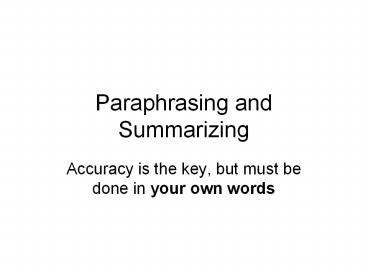Paraphrasing and Summarizing - PowerPoint PPT Presentation
Title:
Paraphrasing and Summarizing
Description:
Paraphrasing and Summarizing Accuracy is the key, but must be done in your own words Paraphrasing It is a tool used in summarizing, but is not a summary ... – PowerPoint PPT presentation
Number of Views:510
Avg rating:3.0/5.0
Title: Paraphrasing and Summarizing
1
Paraphrasing and Summarizing
- Accuracy is the key, but must be done in your own
words
2
Paraphrasing
- It is a tool used in summarizing, but is not a
summary writing itself. It is shorter - The aim is to re-present the information and
concept in different words - Not always shorter than the original
3
Things to note
- Source information (page/paragraph )
- Avoid stringing together more than 3 words from
the original (Plagiarism) - Avoid looking at the original when paraphrasing
4
Example
- With few exceptions, nurse theorists have not
elaborated upon the concept of environment, even
though it is a central element in the nursing
paradigm (person, health, nursing, and
environment). (Chopprian, 1986, p. 39)
5
Sample Paraphrase
- Although environment is the most important part
of the nursing paradigmwhich looks at the
person, the health of the patient, the practice
of nursing, and the environmentnot many have
discussed the environment in any detail.
(Chopoorian, 1986)
6
Summarizing
- Use paraphrasing skills, as well as
mapping/outlining skills - The aim is to re-write the original in a
significantly shortened form - Aim for clarity, conciseness and use of your own
words
7
Tips
- Read the article and draft up the outline thesis
and main points - Identify the title and the writer of the article
in the first sentence of the summary - Identify the topic sentences throughout the
article and use only the most important points - Do not provide supporting details of the main
points - Write the summary (Lovrick, 2007, p. 42)
8
Quotation
- If the passage has less than 40 words, use
quotation marks - proper indentation, but no quotation marks, if
the passage has more than 40 words - Avoid too many quotations, and avoid stringing
quotations together need to show mastery of the
material through paraphrasing/summarizing
9
Use quotation only when
- Really need the support from an authority
- Need to back up the interpretation of a passage
(paraphrasing and/or summarizing) - Need to show exactly what someone else has said
(to show how different your view is) - Want to show (or cant match) the
power/elegance/beauty of the original (Reinking,
2010, p. 414)
10
References
- Chopoorian, T. J. (1986). Reconceptualizing the
- environment. In P. Moccia (Ed.), New approaches
to theory development (pp. 39-54), New York NLN. - Loverick, P. (2007). Focus on College Reading
- and Writing. Toronto Thomson/Nelson.
- Reinking, J., von der Osten, R., Cairns, S. A.,
- Fleming, R. (2010). Strategies for successful
- writing. 4th Can. ed. Toronto Pearson.































